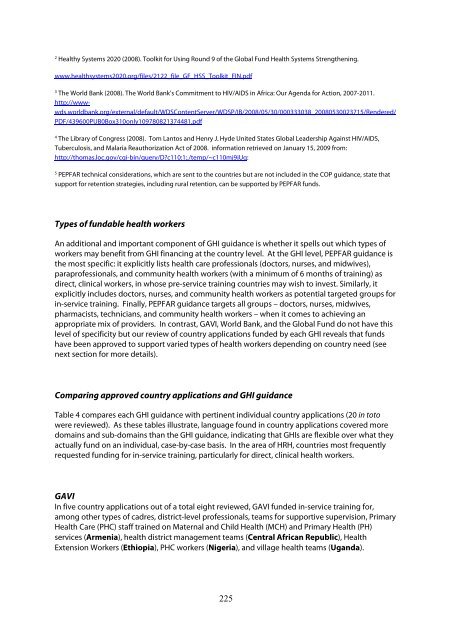MAXIMIZING POSITIVE SYNERGIES - World Health Organization
MAXIMIZING POSITIVE SYNERGIES - World Health Organization
MAXIMIZING POSITIVE SYNERGIES - World Health Organization
You also want an ePaper? Increase the reach of your titles
YUMPU automatically turns print PDFs into web optimized ePapers that Google loves.
2 <strong>Health</strong>y Systems 2020 (2008). Toolkit for Using Round 9 of the Global Fund <strong>Health</strong> Systems Strengthening.<br />
www.healthsystems2020.org/files/2122_file_GF_HSS_Toolkit_FIN.pdf<br />
3 The <strong>World</strong> Bank (2008). The <strong>World</strong> Bank’s Commitment to HIV/AIDS in Africa: Our Agenda for Action, 2007-2011.<br />
http://wwwwds.worldbank.org/external/default/WDSContentServer/WDSP/IB/2008/05/30/000333038_20080530023715/Rendered/<br />
PDF/439600PUB0Box310only109780821374481.pdf<br />
4 The Library of Congress (2008). Tom Lantos and Henry J. Hyde United States Global Leadership Against HIV/AIDS,<br />
Tuberculosis, and Malaria Reauthorization Act of 2008. information retrieved on January 15, 2009 from:<br />
http://thomas.loc.gov/cgi-bin/query/D?c110:1:./temp/~c110mj9jUg:<br />
5 PEPFAR technical considerations, which are sent to the countries but are not included in the COP guidance, state that<br />
support for retention strategies, including rural retention, can be supported by PEPFAR funds.<br />
Types of fundable health workers<br />
An additional and important component of GHI guidance is whether it spells out which types of<br />
workers may benefit from GHI financing at the country level. At the GHI level, PEPFAR guidance is<br />
the most specific: it explicitly lists health care professionals (doctors, nurses, and midwives),<br />
paraprofessionals, and community health workers (with a minimum of 6 months of training) as<br />
direct, clinical workers, in whose pre-service training countries may wish to invest. Similarly, it<br />
explicitly includes doctors, nurses, and community health workers as potential targeted groups for<br />
in-service training. Finally, PEPFAR guidance targets all groups – doctors, nurses, midwives,<br />
pharmacists, technicians, and community health workers – when it comes to achieving an<br />
appropriate mix of providers. In contrast, GAVI, <strong>World</strong> Bank, and the Global Fund do not have this<br />
level of specificity but our review of country applications funded by each GHI reveals that funds<br />
have been approved to support varied types of health workers depending on country need (see<br />
next section for more details).<br />
Comparing approved country applications and GHI guidance<br />
Table 4 compares each GHI guidance with pertinent individual country applications (20 in toto<br />
were reviewed). As these tables illustrate, language found in country applications covered more<br />
domains and sub-domains than the GHI guidance, indicating that GHIs are flexible over what they<br />
actually fund on an individual, case-by-case basis. In the area of HRH, countries most frequently<br />
requested funding for in-service training, particularly for direct, clinical health workers.<br />
GAVI<br />
In five country applications out of a total eight reviewed, GAVI funded in-service training for,<br />
among other types of cadres, district-level professionals, teams for supportive supervision, Primary<br />
<strong>Health</strong> Care (PHC) staff trained on Maternal and Child <strong>Health</strong> (MCH) and Primary <strong>Health</strong> (PH)<br />
services (Armenia), health district management teams (Central African Republic), <strong>Health</strong><br />
Extension Workers (Ethiopia), PHC workers (Nigeria), and village health teams (Uganda).<br />
225

















